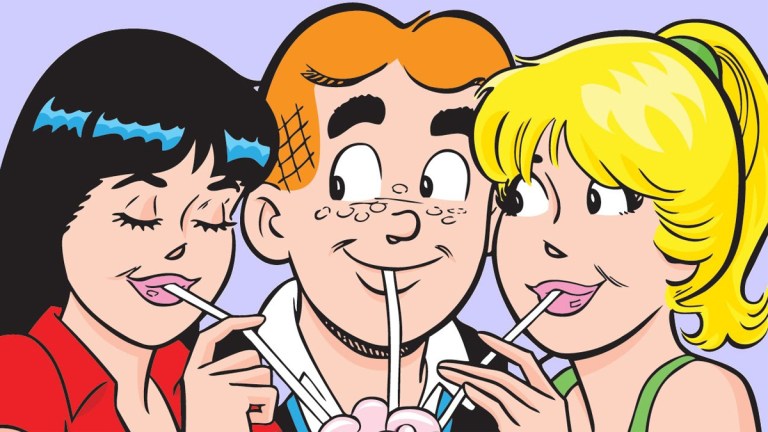The Roots of Riverdale: Archie Comics Turns 80
Archie Comics turns 80 this year, we caught up with the architects of the Archieverse to celebrate “America’s Typical Teenager.”

“It’s a golden age to be an Archie Comics fan right now,” says company president Mike Pellerito with infectious enthusiasm, adding “I just can’t imagine a better time.”
The declaration is more than accurate, as the independently owned publisher is celebrating its 80th anniversary with the massive CW hit Riverdale entering its sixth season (one that will bring on board Kiernan Shipka’s teenage witch from the late, lamented Netflix series Chilling Adventures of Sabrina as a guest star). Despite the TV success, comics are still Archie’s bread and butter, from the digest reprints that beg for impulse buys at the supermarket to a series of innovative titles that have seen Archie and his “pals and gals” become critical darlings.
Some history: In December of 1941, MLJ Comics – a publisher then best known for its stable of superheroes like The Shield, a patriotic figure who predates Captain America – released Pep #22, featuring a backup story focusing on lovable klutz Archie Andrews. It was an instant success due to the humor and charm of its cast, which included lovely girl-next-door Betty Cooper and oddball pal Jughead Jones (Veronica Lodge was not yet part of the picture).
Created by MLJ publisher John L. Goldwater and artist Bob Montana, Archie drew influence from the era’s youth-based Andy Hardy films and successfully predicted how teenage life would become the fulcrum for popular culture in the following decades. Indeed “America’s typical teenager” (as the tagline for Archie’s solo book claimed) became so beloved that MLJ renamed itself in his honor. The peak of Archiemania was 1969, when the cartoon group The Archies, created by rock impresario Don Kirshner and featured on Filmation’s hit The Archie Show, had the number one song of the year with their eternal earworm “Sugar Sugar.”
Since 1987 Dan Parent has been writing and illustrating for Archie and he views the “common sustaining thread through the entire history of Archie Comics has been that love triangle.”
Indeed, the eternal Archie/Betty/Veronica love triangle is such a strong narrative framework that thousands of stories have been built upon it – and everyone who is familiar with these characters has a strong opinion about who Archie should wind up with and why.
The 2010s saw Archie begin a series of daring moves that would establish the brand as an industry innovator, from the magazine Life with Archie: The Married Life to the introduction of Kevin Keller, Riverdale’s first openly gay resident, created by Parent (and recently the focus of a successful Kickstarter that will see the publishing of an omnibus packed with over 700 pages of Kev’s adventures). Then came the horror titles Afterlife with Archie and Chilling Adventures of Sabrina, which paved the way for the television Archieverse.
All of which is to say that Archie is experiencing a creative renaissance despite having recently turned 80.
“The character archetypes are so flexible and work in so many different settings that you can throw them into anything and they would stand,” explains Archie Senior Director of Editorial and Betty and Veronica: Vixens (in which the pair awesomely led a biker gang) creator/writer Jamie Lee Rotante. “No matter what genre, what time span, it just works because the characters are so well defined.”
Director of Publicity and Social Media Ron Cacace (whose work with artist Vincent Lovallo on the viral Bite Size Archie comics on Twitter became a sensation) credits Archie stories not getting bogged down in their own mythology as a key reason to their ongoing success.
“They’re not, for the most part, these long, ongoing dramas like you may have in superhero stories,” he explains. “You can pick up any Archie issue, any Archie digest, and immediately within five pages get a grasp of who these characters are, what the situation is, what they’re going through, and you just want to read the next one.”
The past 80 years have seen Archie rocking out with the likes of The B52’s and Kiss, getting killed, fighting zombies, serving in World War II, etc. Yet at his core he remains “America’s typical teenager.” A fact that Archie Comics President Mike Pellerito attributes to the longevity of these characters. “This is a fun group of kids to hang out with that you want to have as friends,” he says. “And I think what makes Archie (characters) special is they always earnestly try their best, even if it turns into a comedic disaster.”
It’s a recipe for success that has been working for 80 years, even if Archie still looks the same as ever.
Over the course of the past 80 years, Archie has published its fair share of oddities. Here are our favorites.
Jughead’s Diner
Publishing titles like the science fiction-tinged Archie 3000 and Jughead’s Time Police, Archie Comics went through a fascinating experimental phase in the early 1990s. A fan favorite book from this era was Dan Parent’s Jughead’s Diner, which had our ever-hungry hero interacting with the wacky denizens of an interdimensional eatery.
Spire Christian Comics
In the 1970s, Archie writer/artist Al Hartley infamously convinced the company to license its characters to Spire Christian Comics, to be sold in religious bookstores. With titles like Archie’s Love Scene and Archie’s Sonshine, these jaw-dropping books featured off-brand takes on the characters that must be read to be believed.
Life with Archie
From mind-controlling teddy bears to Deliverance homages, the 1970s run of Life with Archie thrust the gang into unbelievable storylines that were as implausible as they were entertaining. For anyone who thinks Riverdale is the first time that Archie got weird, we point them in this comic’s direction.
Little Archie
Created by writer/artist Bob Bolling in 1956, Little Archie was an early example of juvenile versions of popular characters. Tonally shifting between humor, whimsy, and excitement—aliens and monsters were commonplace—these stories also had a melancholy edge that still make them essential reading.
